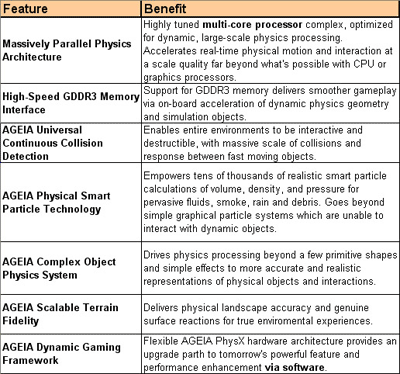BFG Ageia PhysX Physics Card
After more than a year of first hearing of Ageia's plan to bring a discrete physics processor to market, we have a retail PPU from BFG in our labs and are testing the world's first physics processor in actual games. The company's preparation of the industry through the implementation of Ageia's Novodex Physics API will likely pay off in spades as developers are becoming very familiar with working with their format. With such high profile engines such as the Unreal Engine 3 already committed to using Ageia's API and having full support for the PhysX hardware, it appears as though the concept of the discrete physics process has finally received vindication.
In the interest of time, we will avoid going through a detailed analysis of the PhysX architecture again and will instead direct your attention to our GDC article which we previously posted as it contains any backup data you'll need. Since our debriefing at GDC, a few additional aspects of the PhysX hardware have come to light though there is now even more mystery surrounding the product as Ageia has been less than forthcoming with the full spectrum of details for their new hardware. Looking at the information posted on the packaging for our retail 128MB BFG PhysX PPU, we find the following table of information:

Going through the list above, a few key items capture our attention. Perhaps the most interesting and controversial statement made is the mention of "multiple cores" in the first description. At this time, the only details of the PPU die is the fact that it is made on a 0.13 process at TSMC and it is roughly 190mm^2 in size. Beyond that, Ageia has been intentionally quiet regarding the finer details of the core and its architecture. Ironically enough, one of the few details Ageia has chosen to share sheds light on our other key item of interest. In the last statement in the list above, we see mention of "feature and performance enhancements via software". As new features are added and optimizations made, the PPU can be paired with new software to fully implement these changes. Unfortunately, we have not yet been able to confirm whether these "upgrades" will be downloadable for free by current PhysX owners or whether there will be an associated charge. Let's hope Ageia is kind to the early adopters and makes these upgrades a free and simple download.

After viewing the diagram above, the mystery behind the unusual triangle packaging is solved as BFG is clearly drawing a parallel to Ageia's "processor triangle" marketing pitch. The irony here is that the CPU and GPU are the only two threats to the overall success and potential of the PPU. Regardless, Ageia has a vision in which these three components compliment each other. Make no mistake, Ageia's plan is to have the physics processor be the third and final portion of the foundation for game development.

Viewing the list of current and upcoming games which will officially support the PhysX hardware we see that in addition to a field of smaller titles, there are still some major keystone titles. Sure, blockbuster titles such as Unreal Tournament 2007 and Warhammer MMORPG goes a long way in validating Ageia's claim for the need of a discrete physics processor. One aspect to note however is that we have no quantitive measure of how deeply the support for the PhysX hardware will be for these titles. As you will see with the analysis of Ghost Recon Advanced Warfighter and CellFactor, there can be an enormous difference in implementation between two games which both support this hardware.






